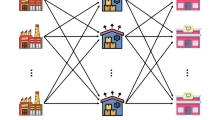Abstract
In the proposed model, we consider the scenario of a supply chain with a single vendor and a single buyer for a single product, taking into consideration the effect of deterioration and credit period incentives. We also consider the situation in which the vendor and the buyer decide upon an investment in ordering cost reduction and coordinate their inventory policies to minimize their joint average annual cost. We study and analyze the benefits of order cost reduction and credit period incentives in a coordinated supply chain. The numerical examples with an exponential ordering cost function are used to evaluate the benefit of the proposed coordinated strategy.
Similar content being viewed by others
References
Banerjee A, Banerjee S (1992) Coordinated, orderless inventory replenishment for a single supplier and multiple buyers through electronic data interchange. Int J Technol Manage 7:328–336
Billington P (1987) The classic economic production quantity model with setup cost as a function of capital expenditure. Decis Sci 18:25–42
Chang HC, Ouyang LY, Wu KS, HO CH (2006) Integrated vendor–buyer cooperative inventory models with controllable lead time and ordering cost reduction. Eur J Oper Res 170:481–495
Coates ER (1996) Manufacturing setup cost reduction. Comput Ind Eng 31:111–114
Gottardi G, Bolisani E (1996) A critical perspective on information technology management. The case of electronic data interchange. Int J Technol Manag 12:369–390
Goyal SK, Gupta YP (1989) Integrated inventory models: the buyer–vendor coordination. Eur J Oper Res 14:261–269
Jacker JV, Rosenblatt MJ (1985) Single period inventory models with demand uncertainly and quantity discounts: behavioral implication and a solution procedure. Nav Res Logist 32:537–550
Luo J (2007) Buyer–vendor inventory coordination with credit period incentives. Int J Prod Econ 108:143–152
Kim S, Hayya J, Hong J (1992) Setup reduction in the economic production quantity. Decis Sci 23:500–508
Lee HL, Rosenblatt MJ (1986) A generalized quantity discount pricing method to increase supplier’s profits. Manage Sci 32:1177–1185
Monahan JP (1984) A quantity discount pricing model to increase profits. Manage Sci 30:720–726
Porteus EL (1985) Investing in reduced setups in the EOQ model. Manage Sci 31:998–1010
Sarkar BR, Jamal, Wang S (2000) Supply chain model for perishable products under inflation and permissible delay in payment. Comput Oper Res 27:380–390
Zhang T, Liang Liang, Yu Y, Yu Y (2007) An integrated vendor-managed inventory model for a two-echelon system with order cost reduction. Int J Prod Econ 109:241–253
Uthayakumar R, Parvathi P (2008) Inventory models with mixture of backorders involving reducible lead time and setup cost. Opsearch 45(1):12–33
Weng ZK (1995) Channel coordination and quantity discounts. Manage Sci 41:1509–1522
Woo YY, Hsu SL, Wu SH (2001) An integrated inventory model for a single vendor and multiple buyers with ordering cost reduction. Int J Prod Econ 73:203–215
Yu YG, Liang L, Wang C, Wang ZQ (2004) An integrated vendor-managed inventory model for deteriorating items. Chin J Manage Sci 12:32–37
Author information
Authors and Affiliations
Corresponding author
Rights and permissions
About this article
Cite this article
Uthayakumar, R., Parvathi, P. A two-stage supply chain with order cost reduction and credit period incentives for deteriorating items. Int J Adv Manuf Technol 56, 799–807 (2011). https://doi.org/10.1007/s00170-011-3207-8
Received:
Accepted:
Published:
Issue Date:
DOI: https://doi.org/10.1007/s00170-011-3207-8




